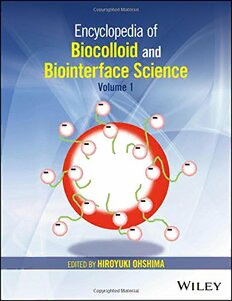Table Of ContentENCYCLOPEDIA OF BIOCOLLOID
AND BIOINTERFACE SCIENCE
ENCYCLOPEDIA OF BIOCOLLOID
AND BIOINTERFACE SCIENCE
VOLUME 1
Editedby
HIROYUKIOHSHIMA
Copyright©2016byJohnWiley&Sons,Inc.Allrightsreserved
PublishedbyJohnWiley&Sons,Inc.,Hoboken,NewJersey
PublishedsimultaneouslyinCanada
Nopartofthispublicationmaybereproduced,storedinaretrievalsystem,ortransmittedinanyformorbyanymeans,electronic,mechanical,
photocopying,recording,scanning,orotherwise,exceptaspermittedunderSection107or108ofthe1976UnitedStatesCopyrightAct,without
eitherthepriorwrittenpermissionofthePublisher,orauthorizationthroughpaymentoftheappropriateper-copyfeetotheCopyrightClearance
Center,Inc.,222RosewoodDrive,Danvers,MA01923,(978)750-8400,fax(978)750-4470,oronthewebatwww.copyright.com.Requeststothe
PublisherforpermissionshouldbeaddressedtothePermissionsDepartment,JohnWiley&Sons,Inc.,111RiverStreet,Hoboken,NJ07030,
(201)748-6011,fax(201)748-6008,oronlineathttp://www.wiley.com/go/permission.
LimitofLiability/DisclaimerofWarranty:Whilethepublisherandauthorhaveusedtheirbesteffortsinpreparingthisbook,theymakeno
representationsorwarrantieswithrespecttotheaccuracyorcompletenessofthecontentsofthisbookandspecificallydisclaimanyimplied
warrantiesofmerchantabilityorfitnessforaparticularpurpose.Nowarrantymaybecreatedorextendedbysalesrepresentativesorwrittensales
materials.Theadviceandstrategiescontainedhereinmaynotbesuitableforyoursituation.Youshouldconsultwithaprofessionalwhere
appropriate.Neitherthepublishernortheauthorshallbeliableforanylossofprofitoranyothercommercialdamages,includingbutnotlimitedto
special,incidental,consequential,orotherdamages.
Forgeneralinformationonourotherproductsandservicesorfortechnicalsupport,pleasecontactourCustomerCareDepartmentwithintheUnited
Statesat(800)762-2974,outsidetheUnitedStatesat(317)572-3993orfax(317)572-4002.
Wileyalsopublishesitsbooksinavarietyofelectronicformats.Somecontentthatappearsinprintmaynotbeavailableinelectronicformats.For
moreinformationaboutWileyproducts,visitourwebsiteatwww.wiley.com.
LibraryofCongressCataloging-in-PublicationData
Names:Ohshima,Hiroyuki,1944–editor.
Title:Encyclopediaofbiocolloidandbiointerfacescience/editedbyHiroyukiOhshima.
Description:Hoboken,NewJersey:JohnWiley&Sons,Inc.,2016–|Includesindex.
Identifiers:LCCN2016004182|ISBN9781118542767(set)|ISBN9781118542682(cloth:v.1)
Subjects:LCSH:Biocolloids–Encyclopedias.|Biologicalinterfaces–Encyclopedias.|Surfacechemistry–Encyclopedias.
Classification:LCCQD549.E532016|DDC547/.134503–dc23LCrecordavailableathttp://lccn.loc.gov/2016004182
10 9 8 7 6 5 4 3 2 1
1 2016
CONTENTS
ListofContributors xxiii
Preface xxix
A
Aerogel
1 StudiesOnBiocompatibleSurface-ActiveSilicaAerogeland
Polyurethane−SiloxaneCross-LinkedStructuresforVariousSurfaces 1
K.SeeniMeera,R.MuraliSankar,S.N.Jaisankar,andAsitBaranMandal
1.1 Introduction, 1
1.1.1 SilicaAerogel, 1
1.1.2 IonicLiquids, 2
1.1.3 Polyurethane–SiloxaneCross-LinkedStructures, 2
1.2 ExperimentalSection, 3
1.2.1 PreparationofSilicaAerogelUsingCholineFormate, 3
1.2.2 PreparationofPolyurethane–SiloxaneCross-LinkedFilms, 3
1.2.3 Characterization, 4
1.3 ResultsandDiscussion, 5
1.3.1 ResultsofSurface-ActiveSilicaAerogel, 5
1.3.2 ResultsofPolyurethane–SiloxaneCross-LinkedStructures, 8
1.4 Conclusions, 12
Acknowledgment, 14
References, 14
Anesthetics
2 InteractionofAnestheticswithGlobularProteins 17
MakotoNishimoto,MichioYamanaka,andHitoshiMatsuki
2.1 Introduction, 17
2.2 AnestheticEffectonFFL, 18
2.3 AnestheticEffectonMgb,Lys,andBSA, 22
2.4 IntrinsicInteractionModeofanAnestheticwithProteins, 29
v
vi CONTENTS
2.5 Conclusions, 32
Acknowledgments, 33
References, 33
3 LipidMonolayerandInteractionwithAnesthetics 36
YasushiYamamotoandKeijiroTaga
3.1 Introduction, 36
3.2 MonolayerFormation, 36
3.2.1 DipalmitoylPhosphatidylCholine(DPPC), 37
3.2.2 DimyristoylPhosphatidylCholine(DMPC), 39
3.2.3 Cholesterol, 40
3.2.4 DPPCandCholesterolMixture, 41
3.2.5 UsefulnessofDroppingMethod, 44
3.3 InteractionbetweenLipidMonolayerandAnesthetics, 44
3.3.1 QuartzCrystalOscillator(QCO)Method, 45
3.3.2 ApparatusesandProcedure, 46
3.3.3 TimeCourseofFrequency(QCM)andResistance(QCI), 48
3.3.4 ConcentrationDependenceofFrequency(QCM)andResistance
(QCI), 49
3.3.5 TrueAnesthesiaPhenomenon, 56
Acknowledgment, 56
References, 57
AtomicForceMicroscopy
4 AtomicForceMicroscopyforMeasuringInteractionForcesinBiological
MaterialsandCells 59
NaoyukiIshida,YasuyukiKusaka,TomonoriFukasawa,andHiroyukiShinto
4.1 Introduction, 59
4.2 MeasurementofInteractionForcesUsingAFM, 60
4.3 InteractionofModelMembranes, 61
4.4 InteractionofProteins, 62
4.5 InteractionofCells, 63
4.6 ConcludingRemarks, 65
References, 65
B
BacterialInteraction
5 BacterialInteractions 68
MasanoriToyofuku,YosukeTashiro,TomohiroInaba,andNobuhikoNomura
5.1 Introduction, 68
5.2 Gram-PositiveandGram-NegativeBacteria, 68
5.3 Cell–CellCommunicationinBacteria, 69
5.3.1 Cell–CellCommunicationinGram-NegativeBacteria, 69
5.3.2 Cell–CellCommunicationinGram-PositiveBacteria, 71
5.3.3 ACommonLanguageforGram-NegativeandGram-Positive
Bacteria:AI-2, 71
5.4 MembraneVesicles, 72
5.4.1 ComponentsofMVs, 72
5.4.2 BiologicalRolesofMVs, 73
CONTENTS vii
5.4.3 SurfaceCharacteristicsofMVs, 73
5.4.4 FuturePerspectivesinMVResearch, 74
5.5 BiofilmFormation, 74
5.5.1 Surface-AttachedBiofilms, 75
5.5.2 BacterialAggregates, 76
5.6 ConcludingRemarks, 77
References, 77
BiocompatiblePolymer
6 2Dand3DBiocompatiblePolymersforBiomedicalDevices 82
MasaruTanaka
6.1 Introduction, 82
6.2 BiocompatiblePolymericBiomaterials, 82
6.3 ProteinAdsorptiononPolymericBiomaterials, 83
6.4 WaterStructureofPolymers, 84
6.5 3DPolymerSurfacesforTissueEngineering, 85
6.6 Methodsof3DPolymerFabrication, 86
6.6.1 Top–DownFabrication, 86
6.6.2 Bottom–UpFabrication, 86
6.7 ControlofCellAdhesionandFunctions, 88
6.8 ConclusionsandPerspectives, 90
Acknowledgments, 91
References, 91
Biofilm
7 Biofilm 94
HisaoMorisaki
7.1 Introduction, 94
7.2 FormationProcessofBiofilm, 94
7.3 BiofilmConstituents, 95
7.3.1 SubstratumSurface, 95
7.3.2 BiofilmMicrobes, 96
7.3.3 ExtracellularPolymericSubstances(EPSs), 97
7.3.4 InterstitialWateramongEPSs, 98
7.4 BiofilmandSurroundingEnvironment, 99
7.4.1 InfluenceofSurroundingEnvironmentonBiofilm, 99
7.4.2 InfluenceofBiofilmonSurroundingEnvironment, 99
7.5 PresentandProspectiveBiofilmResearch, 100
References, 101
Bioflotation
8 UseofMicroorganismsforComplexOREBeneficiation:Bioflotationas
anExample 108
AkiraOtsuki
8.1 Introduction, 108
8.2 CharacterizationofComplexOres, 108
8.2.1 MineralAnalysisinDryState, 108
8.2.2 Mineral/ParticleAnalysisinWater, 109
8.2.3 MixtureofComplementaryAnalyses, 111
viii CONTENTS
8.2.4 RefractoryGoldOreBeneficiation, 111
8.2.5 SulfideFlotationUsingaMicroorganismasaFlotationReagent, 111
8.3 Summary, 116
References, 116
Biofouling
9 Biofouling 118
KazuhoNakamura
9.1 DefinitionofBiofouling, 118
9.2 FormationofBiofilms, 118
9.3 BiofoulinginIndustries, 118
9.3.1 BiofoulinginHeatExchangers, 119
9.3.2 BiofoulingofMedicalDevices, 119
9.3.3 BiofilmsinWastewaterTreatmentProcesses, 120
9.3.4 BiofoulinginMembraneProcesses, 121
References, 121
Bio-inspiredMicroemulsion
10 BioinspiredMicroemulsionsandTheirStrategicPharmacological
Perspectives 122
SoumikBardhan,KaushikKundu,GulmiChakraborty,BidyutK.Paul,SatyaP.Moulik,
andSwapanK.Saha
10.1 Introduction, 122
10.2 ABriefOutlineofMicroemulsionSystems, 123
10.2.1 TypesofMicroemulsionSystems, 124
10.2.2 RoleofSurfactantinFormationofMicroemulsions, 124
10.2.3 RoleofCosurfactantinFormationofMicroemulsions, 124
10.2.4 RoleofOilinFormationofMicroemulsions, 125
10.2.5 SolubilizationinMicroemulsions, 125
10.2.6 CharacterizationofMicroemulsions, 125
10.2.7 StabilityofMicroemulsions, 125
10.3 DesignStrategyforBioinspiredMicroemulsionSystems, 126
10.3.1 SelectionofIngredients, 126
10.3.2 TypesofBioinspiredMicroemulsions, 127
10.3.3 DecisiveFactorsforPharmaceuticalApplications, 129
10.4 RecentAdvancesinBioinspiredMicroemulsionsinPharmaceutical
Science, 129
10.4.1 MicroemulsionsasinVitroDrugDeliverySystems, 129
10.4.2 MicroemulsionsasinVivoDrugDeliverySystems, 131
10.4.3 MicroemulsionsinCancerTherapy, 132
10.4.4 MicroemulsionsinBiotechnology, 133
10.4.5 AntimicrobialActivityofMicroemulsions, 134
10.4.6 BiocompatibleIonicLiquidMicroemulsionsinDrugDelivery
andBiotechnology, 135
10.4.7 PatentsinMicroemulsionDrugDeliverySystems, 136
10.5 BiocompatibilityandToxicityIssues, 137
10.6 FutureOutlook, 138
Acknowledgment, 138
References, 138
CONTENTS ix
Biomaterial
11 DevelopmentofNonfoulingBiomaterials 145
Ruey-YugTsayandToyokoImae
11.1 Introduction, 145
11.2 WhyNonfoulingisRelevantinBiomaterials, 145
11.2.1 AntithrombogenesisandAnti-inflammatoryResponse, 145
11.2.2 HostResponsetoBiomaterials, 146
11.2.3 AntibacterialProperty, 147
11.3 ProteinAdsorptionandMaterialProperties, 148
11.3.1 AdsorptionMechanismofProtein, 148
11.3.2 Protein–SurfaceInteractions, 148
11.3.3 SurfaceHydration, 149
11.3.4 StrategiesforNonfoulingDesign, 149
11.4 NonfoulingBiomaterials, 150
11.4.1 SurfaceImmobilizationTechniques, 151
11.4.2 NonionicHydrophilicMaterials, 153
11.4.3 ZwitterionicMaterials, 154
11.4.4 AmphiphilicMaterials, 156
11.5 ConclusionsandFuturePerspectives, 157
References, 157
12 SurfaceCharacterizationofSilverandFe O NanoparticlesIncorporated
3 4
intoCollagen-basedScaffoldsasBiomaterialsforTissueRegeneration:
State-of-the-ArtandFuturePerspectives 161
AbhishekMandal,N.Chandrasekaran,AmitavaMukherjee,andThothapalliP.Sastry
12.1 Introduction, 161
12.2 StructuralInformation, 163
12.2.1 SDS-PAGEAnalysis, 163
12.2.2 CircularDichroism(CD)Studies, 164
12.2.3 DifferentialScanningCalorimetry(DSC), 165
12.2.4 X-RayDiffraction(XRD), 166
12.3 ChemicalInformation, 167
12.3.1 FourierTransformInfrared(FT-IR)Spectroscopy, 167
12.3.2 X-RayPhotoelectronSpectroscopy(XPS), 168
12.4 MorphologicalInformation, 171
12.4.1 ScanningElectronMicroscopy(SEM), 171
12.4.2 AtomicForceMicroscopy(AFM), 173
12.5 ConclusionsandFuturePerspectives, 175
Acknowledgment, 175
References, 175
Biomimetics
13 BiomimeticPolymerAggregates:Self-AssemblyInducedbyChemical
Reactions 181
EriYoshida
13.1 Introduction, 181
13.2 Self-AssemblyInducedbyElectronTransfer, 181
13.2.1 Oxidation-InducedSelf-Assembly, 182
13.2.2 Reduction-InducedSelf-Assembly, 184
13.2.3 Disproportionation-InducedSelf-Assembly, 184
x CONTENTS
13.3 Self-AssemblyInducedbyIrreversiblePhotoreactions, 186
13.3.1 Photolysis-InducedSelf-Assembly, 188
13.3.2 Photo-ClaisenRearrangement-InducedSelf-Assembly, 189
13.3.3 PhotoelectronTransfer–InducedSelf-Assembly, 190
13.4 Conclusions, 191
References, 191
14 MolecularInteractioninBiomimeticsandBiosystems:Chiralityand
ConfinementatNanodimension 195
NilashisNandiandSahebDutta
14.1 Introduction, 195
14.2 MethodsofTheoreticalCalculation, 198
14.3 ChiralDiscriminationinBiomimeticMonolayers, 198
14.4 ExperimentalStudiesonChiralDiscriminationinPeptideSynthesisand
AminoacylationReaction, 199
14.5 ComputationalAnalysisofChiralDiscriminationinAminoacylation
Reaction, 202
14.6 ComputationalStudiesoftheChiralDiscriminationinPeptideBond
FormationReaction, 204
14.7 ConcludingRemarks, 206
Acknowledgments, 207
References, 207
Biosensing
15 SoftinterfaceonBiosensing 211
YukichiHoriguchiandYukioNagasaki
15.1 Introduction, 211
15.2 AdvantagesofSuppressingtheNonspecificAdsorptiononaSurfaceby
PEGylation, 212
15.3 PegChainBehavioronSurfaces, 212
15.4 FunctionalizationofPEGEndforPEGylationonSurface, 214
15.5 HybridImmobilizationofPEGwithLigandMolecules, 215
15.6 Conclusion, 217
References, 217
Bioseparation
16 BioseparationUsingThermoresponsivePolymers 220
KenichiNagaseandTeruoOkano
16.1 Introduction, 220
16.2 ThermoresponsiveChromatographywithHydrophobicInteractions, 220
16.3 ThermoresponsiveChromatographywithElectrostaticInteractions, 222
16.4 ThermoresponsiveChromatographyUsingVolumeExclusionEffectof
PIPAAm, 224
16.5 ThermoresponsiveChromatographyforHigh-SpeedSeparation, 226
16.6 ThermallyModulatedCellSeparationUsingPIPAAm, 227
16.7 Conclusions, 228
Acknowledgment, 229
References, 229
CONTENTS xi
Biosurfactant
17 Biosurfactants 231
EtsuoKokufuta
17.1 Introduction, 231
17.2 Classification, 231
17.3 ChemicalandPhysicalProperties, 239
17.4 Applications, 242
References, 243
Blood-brainBarrier
18 StructureandRegulationoftheBlood–BrainBarrier 244
Yung-ChihKuo,Chin-LungLee,andJyh-PingHsu
18.1 Introduction, 244
18.2 CellularSystemoftheBBB, 244
18.2.1 TightJunctions, 244
18.2.2 NeurovascularUnit, 245
18.2.3 BMECs, 245
18.2.4 Astrocytes, 245
18.2.5 Pericytes, 246
18.3 InVitroBBBModel, 246
18.3.1 PrimaryCulture, 247
18.3.2 Coculture, 247
18.4 ABCTransportersintheBBB, 247
18.4.1 MechanismofABCTransporters, 247
18.5 SecretedFactorsforBBBRegulation:MechanismandInhibitor, 247
18.5.1 TGF𝛽1, 248
18.5.2 VEGF, 248
18.5.3 MMP-9, 248
18.6 NanoparticlesforDeliveringPharmaceuticalsAcrosstheBBB, 248
Acknowledgments, 250
Abbreviations, 250
References, 250
BoronTracedrug
19 BoronTracedrugsasTheranosticAgentsforNeutronDynamicTherapy 255
HitoshiHoriandHiroshiTerada
19.1 TheRealCrisisforTwenty-First-CenturyMedicinalChemistsin
PharmaceuticalIndustriesandAcademia, 255
19.2 BoronTracedrugsasaChallengetoTraditionalDrugDesignMethodology, 255
19.3 BoronTracedrugsforNeutronDynamicTherapy(NDT),as
Physician-FriendlyTools, 257
19.4 Conclusions, 258
Acknowledgment, 259
References, 259

